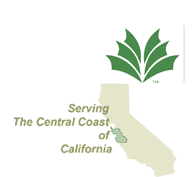Oak Diseases
There are several diseases of oak trees that left untreated, will eventually kill a tree. It is important to note that many diseases are a direct result of cultural changes beneath the canopy of a tree. Unknowingly, a contractor or homeowner may contribute to decline of their trees. As a rule, do not make drastic changes beneath the canopy of oak trees. Preferably, this area plus at least one third of the distance between the trunks should be a zone of no disturbance.
Phytophthora sp.
Phytophthora root rot is a soil-borne pathogen. It requires warm soil temperatures and high soil moisture to reproduce. It rots the feeder roots and sometimes produces bleeding symptoms on the trunk of trees. Planting a lawn beneath an oak tree canopy often triggers it. Our native oak species do not want summer water beneath the canopy. These trees are adapted to summer drought followed by wet winters. Occasionally, when winter drought stress occurs, supplemental watering is warranted. Consult with a certified arborist for mitigative procedures. Another triggering mechanism for Phytophthora is the buildup of soil or mulching material onto the trunk of a tree. This creates an environment that this pathogen thrives upon. Landscape projects oftentimes require a buildup of soil beneath a tree canopy. This practice is especially devastating to tree health. Adding soil and soil compaction during construction is a common mistake. Unfortunately, this mistake may not be noticed until too much damage has been done to a tree.
Armillaria sp. – Oak Root Fungus
Oak root fungus is probably the most common pathogen of root and tree trunks. It does not take too much to encourage its growth. Clusters of mushrooms growing near the root flares commonly identify infection. White mycelial fans, which are sheets of fungal growth just beneath cracked bark of the trunk, is a positive visual sign. When a trees defense system is compromised by things such as over watering, nutrient deficiency, or excess soil build up around the base or on top of the root zone of a tree, this opportunistic pathogen can invade. It is estimated that this fungal pathogen may survive in soils 20-50 years.
The good news is, if the situations that can lead to these problems are spotted in time mitigative procedures can reverse the decline. Consult with a certified arborist for such procedures.
Bacterial Wetwood
Considered to be a benign bacterial infection, wetwood or slime flux as it is also known, usually does not cause severe damage to a tree. It is commonly diagnosed as a fungal pathogen, and sometimes treatment is recommended. This condition is best left alone as treatment will allow insect and fungal diseases to enter the wound site that is left behind after treatment.
Dr. Alex Shigo describes wetwood as follows:
Wetwood – Wetwood is wood infected by anaerobic bacteria mostly. The infected wood is altered in ways that disrupt membranes, high pH, and low amounts of free oxygen as micro spaces are filled with water and leakage of substances leads to high concentrations of elements. These alterations create a niche. Wetwood is a type of protection wood similar to discolored wood in early stages, except that the infecting microorganisms are usually anaerobic bacteria. They also infect wounds, branch stubs and root stubs. The bacteria so alter the wood -high pH, high moisture; low oxygen -that infection by decay-causing fungi is stalled. Spider heart is a common feature in forest trees, especially white oaks. As the first crack forms, other cracks form that equalizes the loading. Rarely will there be only one major crack or seam in a forest tree. Wetwood lubricates the cracks.

